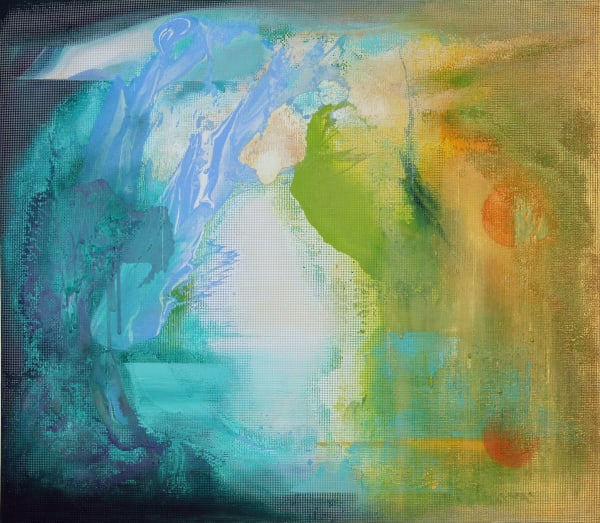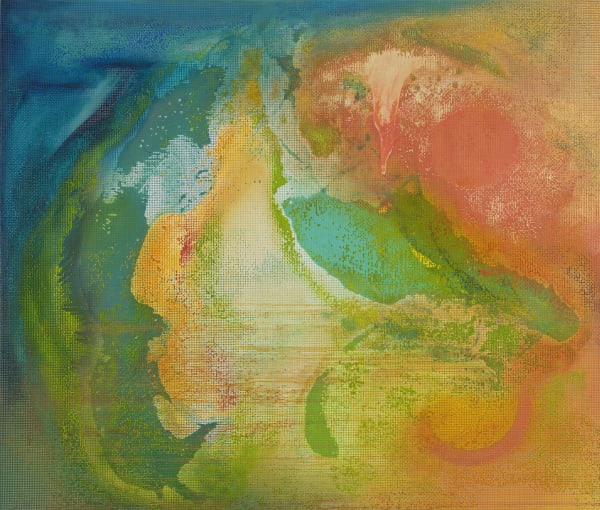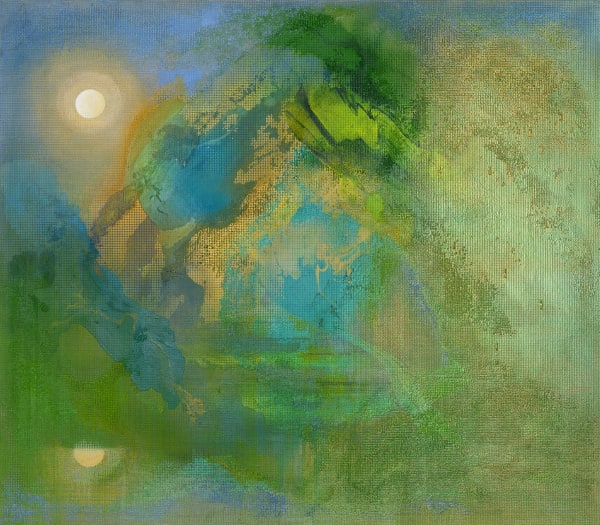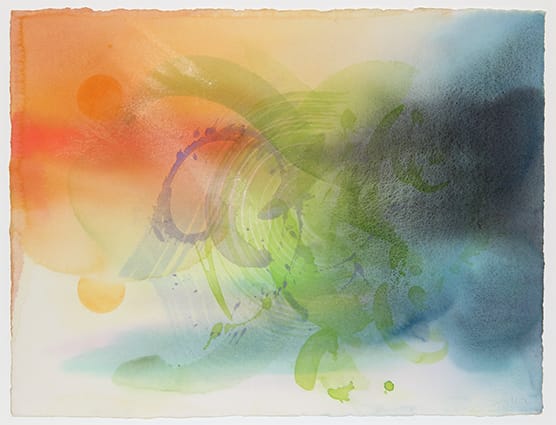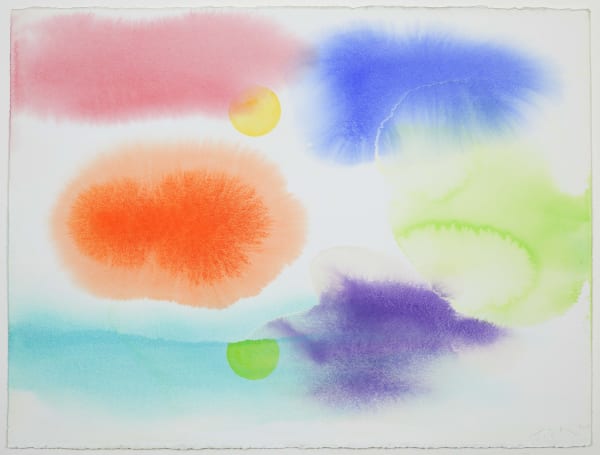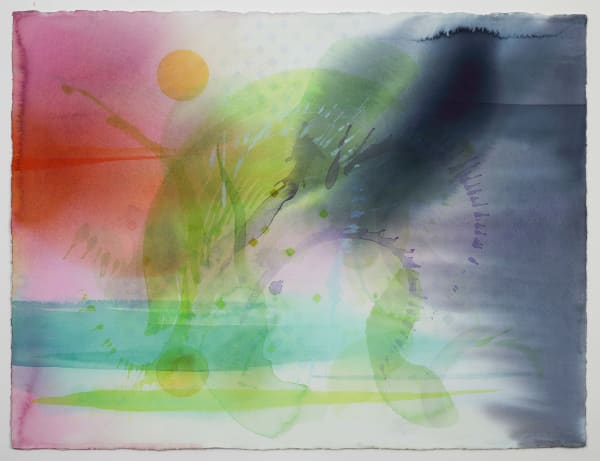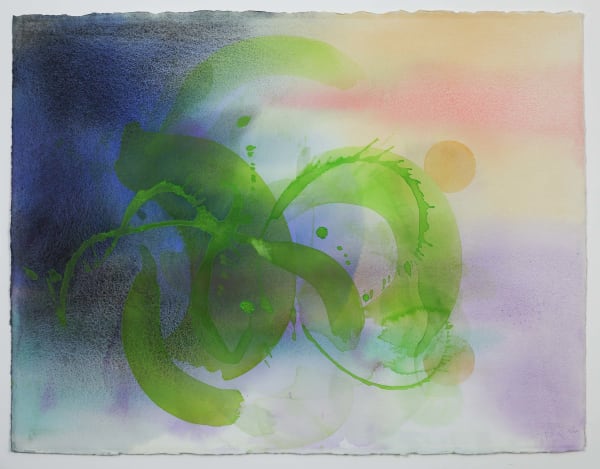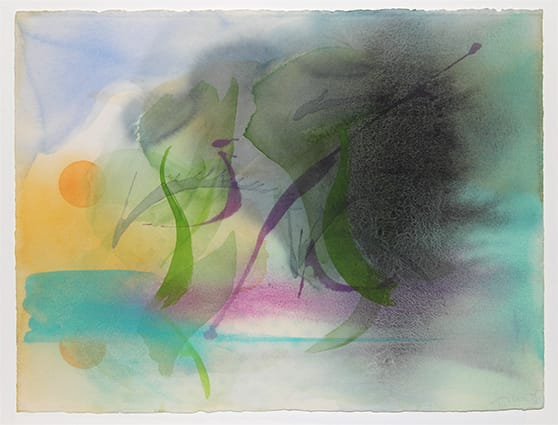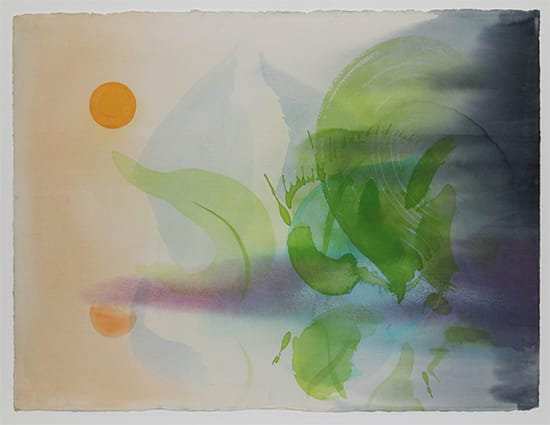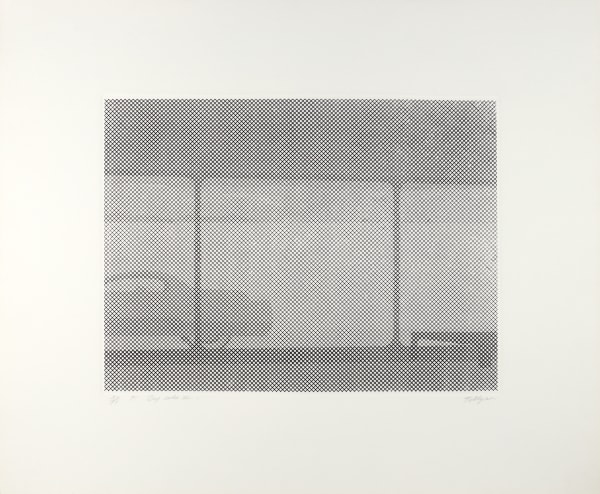William Tillyer: The Watering Place
-
Bernard Jacobson Gallery presents William Tillyer: The Watering Place (2013), a cycle of experimental Landscape paintings created from acrylic paint, mesh and canvas by British artist William Tillyer (b.1938). The exhibition will also feature watercolours and prints relating to ‘The Watering Place.'
-
-
 William TillyerThe Watering Place I, 2013signed (verso)Acrylic on acrylic mesh and canvas177.8 x 203.2 cms (70 x 80 ins)
William TillyerThe Watering Place I, 2013signed (verso)Acrylic on acrylic mesh and canvas177.8 x 203.2 cms (70 x 80 ins) -
 William TillyerThe Watering Place II, 2013Signed (verso)Acrylic on acrylic mesh and canvas177.8 x 203.2 cms (70 x 80 ins)
William TillyerThe Watering Place II, 2013Signed (verso)Acrylic on acrylic mesh and canvas177.8 x 203.2 cms (70 x 80 ins) -
 William TillyerThe Watering Place III, 2013Signed (verso)Acrylic on acrylic mesh and canvas177.8 x 203.2 cms (70 x 80 ins)
William TillyerThe Watering Place III, 2013Signed (verso)Acrylic on acrylic mesh and canvas177.8 x 203.2 cms (70 x 80 ins) -
 William TillyerThe Watering Place IV, 2013Signed (verso)Acrylic on acrylic mesh and canvas177.8 x 203.2 cms (70 x 80 ins)
William TillyerThe Watering Place IV, 2013Signed (verso)Acrylic on acrylic mesh and canvas177.8 x 203.2 cms (70 x 80 ins)
-
 William TillyerThe Watering Place V, 2013Signed (verso)Acrylic on acrylic mesh and canvas177.8 x 203.2 cms (70 x 80 ins)
William TillyerThe Watering Place V, 2013Signed (verso)Acrylic on acrylic mesh and canvas177.8 x 203.2 cms (70 x 80 ins) -
 William TillyerThe Watering Place VI, 2013Signed (verso)Acrylic on acrylic mesh and canvas177.8 x 203.2 cms (70 x 80 ins)
William TillyerThe Watering Place VI, 2013Signed (verso)Acrylic on acrylic mesh and canvas177.8 x 203.2 cms (70 x 80 ins) -
 William TillyerThe Watering Place 5, 2013Watercolour on Arches paper57.2 x 76.8 cms (22 1/2 x 30 1/4 ins)
William TillyerThe Watering Place 5, 2013Watercolour on Arches paper57.2 x 76.8 cms (22 1/2 x 30 1/4 ins) -
 William TillyerThe Watering Place, 2013Watercolour on Arches paper57.2 x 76.8 cms (22 1/2 x 30 1/4 ins)
William TillyerThe Watering Place, 2013Watercolour on Arches paper57.2 x 76.8 cms (22 1/2 x 30 1/4 ins)
-
 William TillyerThe Watering Place, 2013Watercolour on Arches paper57.2 x 76.8 cms (22 1/2 x 30 1/4 ins)
William TillyerThe Watering Place, 2013Watercolour on Arches paper57.2 x 76.8 cms (22 1/2 x 30 1/4 ins) -
 William TillyerThe Watering Place, 2013Watercolour on Arches paper57.2 x 76.8 cms (22 1/2 x 30 1/4 ins)
William TillyerThe Watering Place, 2013Watercolour on Arches paper57.2 x 76.8 cms (22 1/2 x 30 1/4 ins) -
 William TillyerThe Watering Place, 2013Watercolour on Arches paper57.2 x 76.8 cms (22 1/2 x 30 1/4 ins)
William TillyerThe Watering Place, 2013Watercolour on Arches paper57.2 x 76.8 cms (22 1/2 x 30 1/4 ins) -
 William TillyerThe Watering Place, 2013Watercolour on Arches paper57.2 x 76.8 cms (22 1/2 x 30 1/4 ins)
William TillyerThe Watering Place, 2013Watercolour on Arches paper57.2 x 76.8 cms (22 1/2 x 30 1/4 ins)
-
 William TillyerThe Watering Place Study, 2013Initialled and titled (verso)Watercolour on paper25.4 x 30.5 cms (10 x 12 ins)
William TillyerThe Watering Place Study, 2013Initialled and titled (verso)Watercolour on paper25.4 x 30.5 cms (10 x 12 ins) -
 William TillyerThe Watering Place Study, 2013Initialled and titled (verso)Watercolour on paper25.4 x 29.8 cms (10 x 11 3/4 ins)
William TillyerThe Watering Place Study, 2013Initialled and titled (verso)Watercolour on paper25.4 x 29.8 cms (10 x 11 3/4 ins) -
 William TillyerThe Watering Place Study , 2013Initialled and titled (verso)Watercolour on paper25.4 x 29.8 cms (10 x 11 3/4 ins)
William TillyerThe Watering Place Study , 2013Initialled and titled (verso)Watercolour on paper25.4 x 29.8 cms (10 x 11 3/4 ins) -
 William TillyerThe Watering Place Study , 2013Initialled and titled (verso)Watercolour on paper25.4 x 29.8 cms (10 x 11 3/4 ins)
William TillyerThe Watering Place Study , 2013Initialled and titled (verso)Watercolour on paper25.4 x 29.8 cms (10 x 11 3/4 ins)
-
 William TillyerThe Watering Place Study - Bridge, 2013Initialled and titled (verso)Watercolour on paper25.4 x 30.5 cms (10 x 12 ins)
William TillyerThe Watering Place Study - Bridge, 2013Initialled and titled (verso)Watercolour on paper25.4 x 30.5 cms (10 x 12 ins) -
 William TillyerThe Watering Place Study - Landscape with Bridge, 2013Initialled and titled (verso)Watercolour on paper24.1 x 29.8 cms (9 1/2 x 11 3/4 ins)
William TillyerThe Watering Place Study - Landscape with Bridge, 2013Initialled and titled (verso)Watercolour on paper24.1 x 29.8 cms (9 1/2 x 11 3/4 ins) -
 William TillyerThe Watering Place I, 2013/2015Signed and datedInkjet on Somerset Photo paper57 x 76.5 cms (22 1/2 x 30 1/8 ins)Edition of 100
William TillyerThe Watering Place I, 2013/2015Signed and datedInkjet on Somerset Photo paper57 x 76.5 cms (22 1/2 x 30 1/8 ins)Edition of 100 -
 William TillyerThe Watering Place II, 2013/2015Signed and datedInkjet on Somerset Photo paper57 x 76.5 cms (22 1/2 x 30 1/8 ins)Edition of 100
William TillyerThe Watering Place II, 2013/2015Signed and datedInkjet on Somerset Photo paper57 x 76.5 cms (22 1/2 x 30 1/8 ins)Edition of 100
-
 William TillyerThe Watering Place III, 2013/2015Signed and datedInkjet on Somerset Photo paper57 x 76.5 cms (22 1/2 x 30 1/8 ins)Edition of 100
William TillyerThe Watering Place III, 2013/2015Signed and datedInkjet on Somerset Photo paper57 x 76.5 cms (22 1/2 x 30 1/8 ins)Edition of 100 -
 William TillyerBlack Venus, 1976Screenprint112.8 x 36 cms (44 1/2 x 14 1/4)Edition 100
William TillyerBlack Venus, 1976Screenprint112.8 x 36 cms (44 1/2 x 14 1/4)Edition 100 -
 William TillyerLattice, 1973Etching106 x 71.2 cms (41 3/4 x 28 ins)Edition
William TillyerLattice, 1973Etching106 x 71.2 cms (41 3/4 x 28 ins)Edition -
 William TillyerA Furnished Landscape - High Force, 1974Edition of 9090.5 x 68.5 cms (35 5/8 x 27 ins)
William TillyerA Furnished Landscape - High Force, 1974Edition of 9090.5 x 68.5 cms (35 5/8 x 27 ins)
-
 William TillyerCourthope Collection - The Lumsden's Vase, 1977Etching75.6 x 56.5 cms (29 3/4 x 22 1/4 ins)Etching
William TillyerCourthope Collection - The Lumsden's Vase, 1977Etching75.6 x 56.5 cms (29 3/4 x 22 1/4 ins)Etching -
 William TillyerCourthope Collection - The Dale Vase with Pinks, 1977Etching75.6 x 56.5 cms (29 3/4 x 22 1/4 ins)Edition of 60
William TillyerCourthope Collection - The Dale Vase with Pinks, 1977Etching75.6 x 56.5 cms (29 3/4 x 22 1/4 ins)Edition of 60 -
 William TillyerThe Lumsden's Pool, 1971Etching on Arches paper23.5 x 27.9 cms (9 1/4 x 11 ins)Edition of 25
William TillyerThe Lumsden's Pool, 1971Etching on Arches paper23.5 x 27.9 cms (9 1/4 x 11 ins)Edition of 25 -
 William TillyerDry Lake IV, 1971Etching55.9 x 66.7 cms (22 x 26 1/4 ins)Edition of 50
William TillyerDry Lake IV, 1971Etching55.9 x 66.7 cms (22 x 26 1/4 ins)Edition of 50
-
 William TillyerDry Lake III, 1971Etching55.9 x 66.7 cms (22 x 26 1/4)Edition of 50
William TillyerDry Lake III, 1971Etching55.9 x 66.7 cms (22 x 26 1/4)Edition of 50 -
 William TillyerDry Lake, 1971Etching55.9 x 66.7 cms (22 x 26 1/4 ins)Edition of 50
William TillyerDry Lake, 1971Etching55.9 x 66.7 cms (22 x 26 1/4 ins)Edition of 50 -
 William TillyerDry Lake II, 1971Etching55.9 x 66.7 cms (22 xc 26 1/4 ins)Edition of 50
William TillyerDry Lake II, 1971Etching55.9 x 66.7 cms (22 xc 26 1/4 ins)Edition of 50 -
 William TillyerOak Leaf and Bridge, 2011Etching on paper44.5 x 55.9 cms (17 1/2 x 22 ins)Edition of 30
William TillyerOak Leaf and Bridge, 2011Etching on paper44.5 x 55.9 cms (17 1/2 x 22 ins)Edition of 30
-
-
Press Release Text
This October, Bernard Jacobson Gallery will present The Watering Place, William Tillyer’s groundbreaking cycle of six luminous landscape paintings.
Tillyer’s Watering Place (2013) takes its point of departure from three masterpieces in the National Gallery, London: Peter Paul Rubens’ The Watering Place (c.1615), Thomas Gainsborough’s The Watering Place (c.1777), and John Constable’s The Hay Wain (1821). In conversation with these canonical works, Tillyer reimagines the pastoral tradition for a contemporary age, dissolving narrative into abstraction and prompting reflection on the fragility of our bond with the natural world.
Rubens’ baroque canvas teems with fecundity and vigour: cattle and horses press forward with muscular force, framed by a landscape of abundance. Gainsborough, by contrast, transforms the motif into a lyrical reverie, suffused with the elegance of the English countryside and the poetics of rustic ease. A century later, Constable’s The Hay Wain extends the motif into the Romantic era. At its centre, a cart crosses the river Stour, a scene ordinary as well as emblematic. Here, water is no longer a mere backdrop but a threshold, a place where labour, livelihood, and nature intersect. Constable’s painting embodies the lived landscape: both working environment and imagined ideal.
Tillyer acknowledges this lineage while radically reconfiguring it. The figures and animals of earlier centuries are absent; instead, colour, form, and atmosphere take over. Painted on industrial mesh supports rather than canvas, these works seem to breathe with the instability of water itself. Pigment seeps, hovers, and disperses; translucent veils yield to geometric scaffolds that disrupt pastoral illusion. Surfaces oscillate between solidity and dissolution. In extending Constable’s meditation on water as a means of passage, Tillyer allows the viewer’s gaze to travel through porous planes and between history and the present.
Tillyer’s technique is as radical as it is distinctive. Working with sheets of plastic mesh hung from the ceiling, he pushes paint of varying viscosity through the grid from both front and back. Thin washes flow and bleed, while thicker pigment bulges forward “like cheese through a grater,” in his own words. This apparent chaos dripping, flooding, brushing, is anchored by a disc motif, positioned high or low in the composition, a sun or a moon hinting at a horizon that invites the viewer to recognise it as a landscape. The Watering Place reflects his enduring commitment to innovation, situating the weight of history within an artistic language that is unmistakably of the present.
In referencing Rubens, Gainsborough, and Constable, Tillyer demonstrates the adaptability and continued relevance of the landscape tradition. While his use of mesh complicates that inheritance: the paintings are simultaneously open and elusive, suggesting that our relationship to nature and to its pictorial representation is no longer stable, but contingent, fragile, and profoundly uncertain.
Alongside the six paintings of The Watering Place, Bernard Jacobson Gallery will also present related watercolours and a selection of limited-edition prints.
Born in Middlesbrough in 1938, William Tillyer has, for more than half a century, interrogated the very possibilities of painting. The American poet and critic John Yau has called him “the most adventuresome artist of his generation.” His work is represented in major public collections including Tate, the Victoria and Albert Museum, and the Museum of Modern Art, New York.
-
Artist
-
Installation Shots

